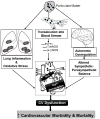Cardiac pathophysiology in response to environmental stress: a current review
- PMID: 29552675
- PMCID: PMC5851460
- DOI: 10.1016/j.cophys.2017.11.005
Cardiac pathophysiology in response to environmental stress: a current review
Abstract
Purpose: Environmental stressors are disturbing our ecosystem at an accelerating rate. An increasingly relevant stressor are air pollutants, whose levels are increasing worldwide with threats to human health. These air pollutants are associated with increased mortality and morbidity from cardiovascular diseases. In this review we discuss environmental stressors focusing mainly on the various types of air pollutants, their short-term and long-term cardiovascular effects, and providing the epidemiological evidence associated with adverse cardiovascular outcomes. Direct and indirect pathophysiological mechanisms are also linked with cardiovascular complications such as thrombosis, fibrinolysis, hypertension, ischemic heart diseases and arrhythmias.
Results: Evidence to date suggests that humans are constantly being exposed to unhealthy levels of environmental toxicants with the potential of serious health conditions. Environmental stressors adversely affect the cardiovascular system and pose an increased risk for cardiovascular diseases for those who reside in highly polluted areas.
Conclusion: People with existing risk factors and those with established cardiovascular disease have increased susceptibility to environmental stressors. The literature reviewed in this article thus support public health policies aimed at reducing pollutant exposure to benefit public health.
Keywords: Particulate matter; cardiovascular mortality; environmental stress; heart; inflammation; oxidative stress.
Figures
Similar articles
-
Proposed pathophysiologic framework to explain some excess cardiovascular death associated with ambient air particle pollution: Insights for public health translation.Biochim Biophys Acta. 2016 Dec;1860(12):2869-79. doi: 10.1016/j.bbagen.2016.07.016. Epub 2016 Jul 22. Biochim Biophys Acta. 2016. PMID: 27451957 Review.
-
Environmental Factors and Hypertension.Curr Pharm Des. 2017;23(22):3239-3246. doi: 10.2174/1381612823666170321162233. Curr Pharm Des. 2017. PMID: 28356035 Review.
-
Synthesis of Harvard Environmental Protection Agency (EPA) Center studies on traffic-related particulate pollution and cardiovascular outcomes in the Greater Boston Area.J Air Waste Manag Assoc. 2019 Aug;69(8):900-917. doi: 10.1080/10962247.2019.1596994. J Air Waste Manag Assoc. 2019. PMID: 30888266 Free PMC article.
-
Part 1. Statistical Learning Methods for the Effects of Multiple Air Pollution Constituents.Res Rep Health Eff Inst. 2015 Jun;(183 Pt 1-2):5-50. Res Rep Health Eff Inst. 2015. PMID: 26333238
-
[Breathing: Ambient Air Pollution and Health - Part II].Pneumologie. 2019 Jun;73(6):347-373. doi: 10.1055/a-0895-6494. Epub 2019 Jun 11. Pneumologie. 2019. PMID: 31185518 Review. German.
Cited by
-
Guidelines for in vivo models of developmental programming of cardiovascular disease risk.Am J Physiol Heart Circ Physiol. 2024 Jul 1;327(1):H221-H241. doi: 10.1152/ajpheart.00060.2024. Epub 2024 May 31. Am J Physiol Heart Circ Physiol. 2024. PMID: 38819382 Free PMC article. Review.
-
Cardiovascular adaptations to particle inhalation exposure: molecular mechanisms of the toxicology.Am J Physiol Heart Circ Physiol. 2020 Aug 1;319(2):H282-H305. doi: 10.1152/ajpheart.00026.2020. Epub 2020 Jun 19. Am J Physiol Heart Circ Physiol. 2020. PMID: 32559138 Free PMC article. Review.
-
Double trouble: combined cardiovascular effects of particulate matter exposure and coronavirus disease 2019.Cardiovasc Res. 2021 Jan 1;117(1):85-95. doi: 10.1093/cvr/cvaa293. Cardiovasc Res. 2021. PMID: 33084879 Free PMC article. Review.
-
Exercise does not ameliorate cardiac dysfunction in obese mice exposed to fine particulate matter.Life Sci. 2019 Dec 15;239:116885. doi: 10.1016/j.lfs.2019.116885. Epub 2019 Oct 23. Life Sci. 2019. PMID: 31655193 Free PMC article.
-
The Cardiovascular Effects of Electronic Cigarettes.Curr Cardiol Rep. 2021 Mar 11;23(5):40. doi: 10.1007/s11886-021-01469-4. Curr Cardiol Rep. 2021. PMID: 33694009 Review.
References
-
- Collaborators, G.B.D.R.F. Global, regional, and national comparative risk assessment of 79 behavioural, environmental and occupational, and metabolic risks or clusters of risks, 1990–2015: a systematic analysis for the Global Burden of Disease Study 2015. Lancet. 2016;388(10053):1659–1724. - PMC - PubMed
-
- Brauer M, et al. Ambient Air Pollution Exposure Estimation for the Global Burden of Disease 2013. Environ Sci Technol. 2016;50(1):79–88. - PubMed
-
- Vaduganathan M, et al. Risk of Cardiovascular Hospitalizations from Exposure to Coarse Particulate Matter (PM10) Below the European Union Safety Threshold. Am J Cardiol. 2016;117(8):1231–5. - PubMed
Grants and funding
LinkOut - more resources
Full Text Sources
Other Literature Sources

